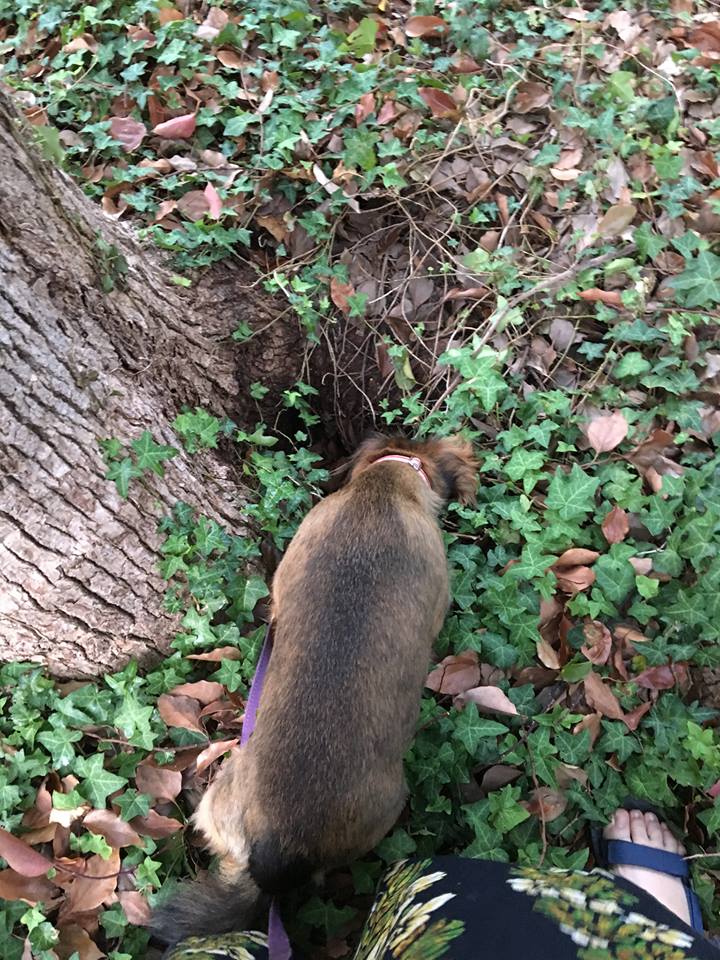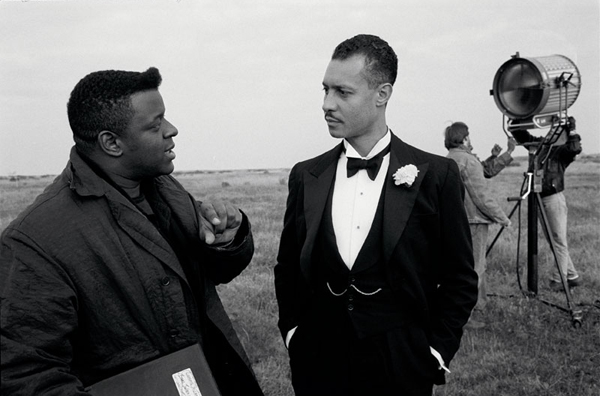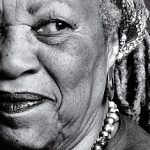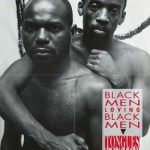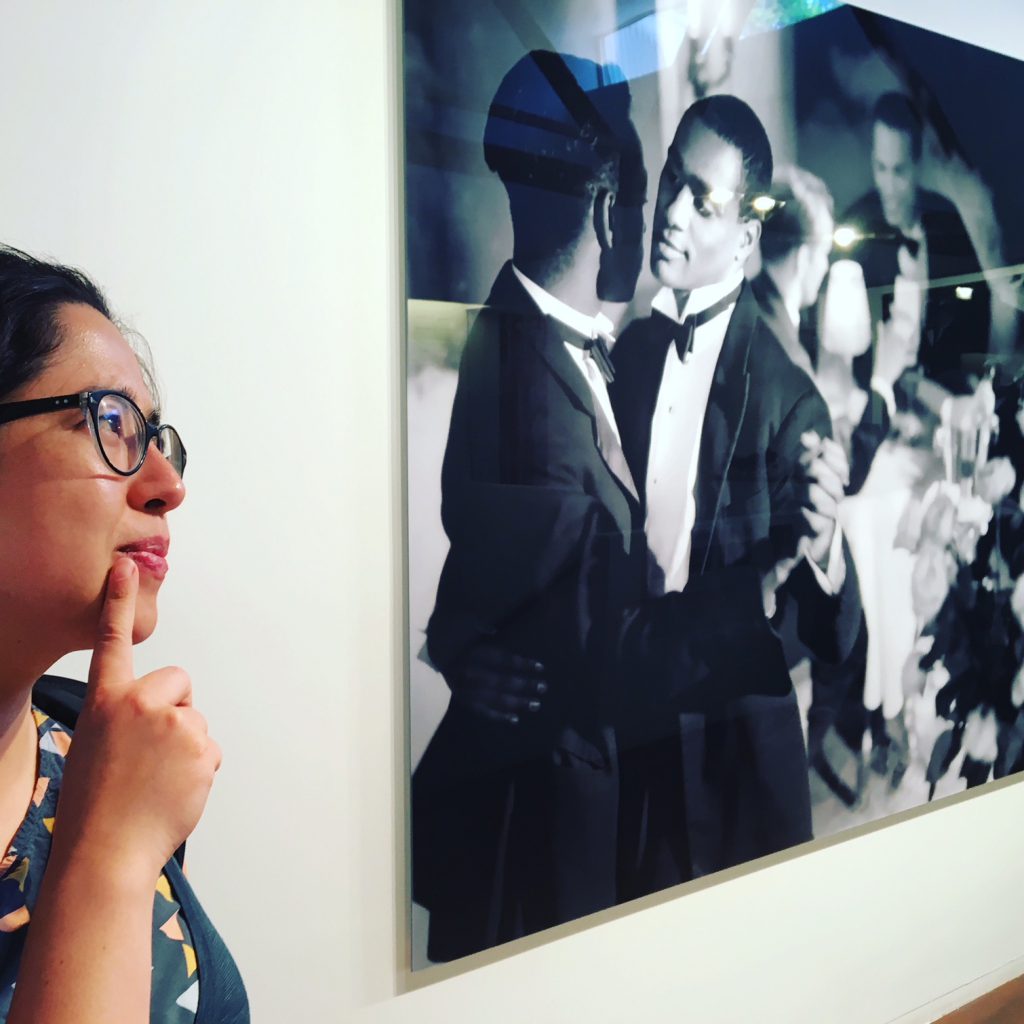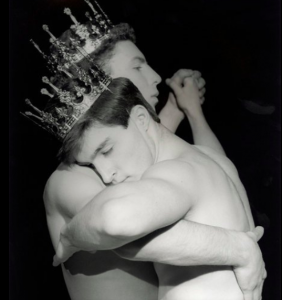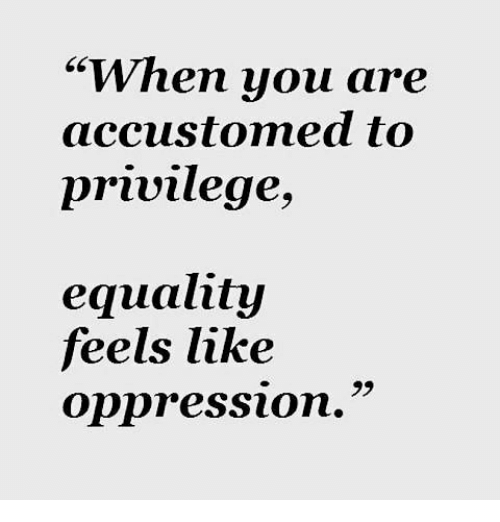Happy new year of the doge.
May your year be full of interesting smells and unusual holes.
Looking for Langston
Speaking of the black experience in jazz and blues dance…
I haven’t yet ready anything in the blues and lindy hop community about the black queer male body dancing.
There’s been some good work on black women’s bodily experiences in modern jazz dance culture, and a bit about black masculinity. Quite a few too many white men have whitesplained how blues works as a black space, and far too many white women and men have avoided talking about vintage fashion as an ethnicised scene.
Apparently the black queer body in a well cut suit or gorgeous gown is too terrifying even for whispers.
I saw Looking For Langston (an art film by Isaac Julien) last night. The whole project – a film made during the 80s AIDS crisis by a black British man, about a black American man of the Harlem Renaissance – is a meditation on queer desire, jazz aesthetics and the blues. The name (and a lot of the content, including some proto-vogueing) reminds me of Desperately Seeking Susan, Madonna, and the queer-eye-on-art. It includes voice work by Stuart Hall and Toni Morrison, Paul Gilroy gets props, Jimmy Somerville plays a cherub (again), and Tongues Untied is referenced. Also there is some cock.
The installation at Rosley Oxley9 Gallery features some beautiful large scale black and white stills from the film, depicting black men dancing in closed embrace. Photos I regularly see linked up on facebook as examples of queer dance in the swing era. Ha.
Liah says it’s good to check out the Mapplethorpe exhibit at the agnsw as well, so you can see how Julien’s work responds to Mapplethorpe (and the white queer gaze on black bodies).
I’ve hooked up this obviously pirated version of Looking for Langston, because it’s a hard one to get to see.
photos:
mise en scene pic from Isaac Julien’s set (source).
Stuart Hall, from his obituary in the Telegraph.
Toni Morrison by Gregg Delman in the Times.
Paul Gilroy (source).
Jimmy Somverville in Sally Potter’s Orlando.
Tongues Untied (source).
My pic from the exhibition.
Robert Mapplethorpe, Two Men Dancing (source).
Vintage fashion and lindy hop: let’s add race.
Laury Windley of Lindy Shopper fame asked on fb today:
I wonder if there’s a correlation between the Internet making vintage and reproduction clothing more available to the masses and the increased incidence of people dressing up for swing dancing.
And I replied…
I think the internet definitely plays a part in shaping lindy hop fashion.
I started dancing in 1998 in Brisbane, a hot, humid sweat pit of a place that was cruel to anything vintage. I was wearing vintage before I started dancing… 60s vintage and punker fashion. But crimplene and sub-tropical lindy hop? No. But that’s 20s years ago, and mainstream fashion has changed a lot over that time.
I think a few things have shaped what people wear for lindy hop:
– Weather and climate.
In hotter climates we sweat more, and fabrics have to be able to handle that. So a wool suit isn’t often a dancer’s first choice. There simply isn’t that much vintage wear in Australia – because the climate (including the sun and sweat) destroyed it, and because of social history.
– Culture.
More importantly, 1930s and 40s fashion in Australia wasn’t like 30s and 40s fashion in the northern hemisphere. I imagine we could see some really interesting different regional vintage fashion in other scenes as well. Which of course makes me think: Korean dancers wearing 30s and 40s fashion is a whole other kettle of cultural fish. Looking at videos from Maputo (in Mozambique) lately, I see a blend of traditional fabrics (eg waxprints), vintage 30s, and modern aesthetic. And bare feet. All things that are particular to this community at this time and place. A pride in cultural heritage (waxprints), a nod to dance history (30s cuts and styles), and social context (bare feet influenced by the ‘traditional’ dance influences brought by pro Mozambique dancers to lindy hop). And that’s all before we get to bodily aesthetics.
– Dance culture.
I’ve noticed that if a lindy hop scene has members who travel a lot (ie they’re quite experienced dancers), the fashion tends more towards the ‘european or american vintage’ aesthetic. This is about individual dancers wanting to signal status/knowledge in what they wear.
Interestingly, we have a strong vintage/repro fashion scene in Sydney which crosses over with ‘swing dancing’ (not necessarily lindy hop). It’s not so great for dancing hardcore, but people live a hardcore vintage lifestyle. Chloe Hong‘s presence in Seoul does much the same. She gives us the incredible troupe uniforms (troupes are influencers!) and also that ubiquitous Whitey’s Lindy Hopper Big Apple tshirt reproduction. Both of which encourage a vintage fashion vibe. And it’s hardcore: male dancer might bring their suit to parties in a suit bag, then change in the on-site dressing rooms rather than risk them on the subway.
– Dancing.
Lindy hop has gotten a lot more athletic _generally_ than it was in the 2000s. Parachute pants are great for smoothy dancing, but a shorter skirt or more fitted trousers are better for lots of solo jazz, leaping about, etc. I’ve been most interested in the way men’s trousers taper more at the ankle to show off leet footwork in a way wide cuffs don’t.
All this athletic training has also changed professional or competition dancers’ physiology: more muscles, a greater range of movement = more care with fashion choices. A lovely 1940s dress is too precious to risk on a hardcore showcase routine with aerials.
– Gender.
We’ve seen changes in gender performance in the wider community since the 1990s and 2000s. There’s generally a greater emphasis on ‘strong’ bodies and muscle tone in mainstream media – women as well as men are into weights and resistance training in a new way. But at the same time, the more androgynous stylings of the 90s has given way to hyper-gendered styles today.
As Grey Armstrong says in that Obsidian Tea piece, this is not only about gender, but also about race, and as Shelby suggests, class. There’s a definite body type favoured by mainstream white culture, but also by lindy hop culture (which is after all a microcosm of the wider society).
Long, lean legs and buttocks, narrow busts and chests, long torsoes, long straight hair, etc etc etc.
Male lindy hoppers’ bodies are almost the same, except with shorter hair (male hair cuts!).
-> we see a very white, anglo-european body type here. It not only excludes black bodies, but also some asian phenotypes…basically anyone who’s not from this anglo-european background.
-> There’s also been a rise in what constitutes disordered eating dogma eating in lindy hop circles: ‘paleo’ ‘diets’, low-carb, high-protein, high-fat, etc etc etc. This in concert with obsessive exercise routines (remember when P90X was big?) are giving us a particularly worrying body type as a favoured aesthetic. Still very white, still relatively unattainable for most people.
The clothes that people are choosing emphasise these qualities. I wrote about the influx of high heeled shoes a while ago – and heels extend the lines of the leg to point the toe and create a very white, heteronormative feminine model. The more fitted skirt extends these straight lines. We see foundation garments becoming a very important part of many women dancers’ wardrobes: they constrain and flatten the body, erasing curves and rolls and dimpling of flesh to extend lines.
All of this actually constrains the body and limits a range of movement, not to mention comfort. Men may complain about the heat of a jacket while dancing, but it’s nothing compared to the discomfort of spanx, two pairs of stockings, underwire bras, a million bobby pins and a ton of makeup. Again, this is very much an ethnicised notion of bodily aesthetics with patriarchal effects.
It’s very _not_ like the west african aesthetics of early jazz dance.
– Fabrics.
Some really wonderful fabrics have become popular in m/s fashion over the past few years. There are some utterly amazing stretch cottons that look and breathe like cotton, but also have the stretch and longevity of a synthetic. Perfect for dancing. But this also changes the way garments wear and wear out. We can make clothes that behave in different ways – reproduce vintage styles in more athletic-friendly fabrics.
– The rise of repro fashion businesses.
This is another story about the internet. Pervasive internet access has enabled the rise of small business manufacturing models (via etsy etc), and the ‘bespoke’ trend in m/s culture has married perfectly with the aesthetics of vintage fashion. So we’re seeing repro businesses doing well online in the dance world and beyond. I think this interest in bespoke fashion works as a push back against fast-fashion, but also as a marker of class (it’s more expensive, and is often defended as being ‘better value’, even when the manufacturers are inexperienced craftspeople who might make things by hand but don’t have proper tailoring skills). This echoes Shelby’s earlier point about ‘respectability’ and race: dressing expensive suggests respectability and status.
I’ve been very interested in the way dancer-run businesses can target the nich dancer market and be sustainable. It works in bigger scenes like Seoul, but it’s also sustainable, via the internet, for a business based in Canberra to market to the international dance world.
– Youtube and social media.
And finally, access to the bodies of dancers all over the world via the internet has shaped fashion. We may have regional styles, but we also have Chloe Hong and Remix and sweet fades in every international lindy hop scene (where budgets allow). If a big name dancer wearing it at ILHC, then we’ll see it in local scenes soon after. Influencers r us.
Figuring out how to teach content in class is lots of work
Lian noted in the teaching swing dance group the other day:
…in the past few years when planning class material, I’ve found it super helpful to focus on HOW we’ll teach it… Will we have them do it solo first, how about shuffling through geography before diving in with footwork, or a progressive series of movement leading to the final concept.
I commented:
[comment]
I think this is the most important thing ever. Making a shift away from moves= content to skills = content has been so important for me. From ‘we’ll teach moves x, y, x’ to ‘our goal is x or y this class. We’ll do this game, then this move, then combine the game with the moves in a section to teach this skill.’
It takes ages, but when we work through how we’ll teach, it’s so much better. Especially if you’re working with a new teacher, or if you want to be a better teacher. Breaking down how you’ll teach makes you more self-reflexive, and actively engage with how you understand a move, how you articulate it, how you can take most of the words out, and how you can encourage students to learn by trying.
Super fun. But it really challenges a teacher to try to improve and change their habits.
[/]
I’m interested in the idea of class planning as a discipline not only for its effects on teaching practice, but also for the way it organises labour before, during, and after classes, and also contributes to teaching team morale and relationships. The time you spend planning helps you figure out how you’ll relate to a teaching partner.
But a very important of my current teaching process, is moving from seeing class ‘content’ as a bunch of moves, to seeing class ‘content’ as much more.
This includes lots of different teaching tools, and knowing how they work individually and cumulatively to develop students’ skills:
– Having ‘goals’ for that specific class
eg ‘integrating different charleston rhythms with lindy hop’
That means knowing what you want to achieve before going in there (because you know your students’ needs), or going in there, observing the students, and thinking ‘ok, they need some X.’
– Having fun games that develop skills required to reach that goal
eg some solo work to learn how your body works
I’m beginning to think that the whole class should be treated like a series of games. ie just making classes a bunch of fun challenges and tasks.
– Beginning every class with a warm up that includes key rhythms or shapes that we’ll use in the class later, but set the tone of the class.
eg kicks for charleston, or pivoting on one foot, or syncopated timing, or dancing across two 8s rather than one
This warm up teaches specific rhythms and shapes, but also teaches them how to learn-by-doing (ie we literally say “Just join in; the goal is to get warmed up”), how to deal with ‘mistakes’ and challenges, and how to move on from one step to another, or from one challenge to another without giving up. It also trains the eye (what do you _see_), and the ear (each move takes a phrase, and uses specific rhythms across moves).
NB We all practice our warm ups very carefully, and don’t just ‘wing’ them.
– Following that with a teacher-led exercise or game like I-go, You-go to teach rhythms.
This second game continues the idea of learn-by-doing, and is lots of fun. These two ‘warm up’ games also begin introducing students to the skills they need for later in the class. So in week 1 of the beginner block we teach the ‘basic rhythm’ using I-go You-go. But we might also use this to teach a particular jazz step or skill.
This game can be made more complex/challenging for more experienced classes. eg from week 1 to week 6 in the beginner block, it gets trickier as their skills increase.
– Paired or small group exercises which are actually dancing.
eg an I-go, you-go exercise where they echo the teacher’s role of calling the step, but take turns being the ‘responder’ as well as the caller, working in turn rather than together.
This then moves them from ‘doing one’ to ‘teaching one’. They learn to ‘teach’ or communicate a rhythm or shape or musical concept with their bodies in a small group (a pair) which is less threatening. It also teaches them to work with a partner (which is central to lindy hop). This develops skills like communication, visual learning (learn by watching), seeing success as a collaboration not an individual victory or competition (eg they ‘win’ if their partner completes the rhythm successfully).
NB These are NOT isolated ‘exercises’, but actually dancing games, where they are literally dancing and experimenting with movement and rhythm.
– Moving to a dance move or figure that employs these skills.
eg a call and response rhythm that happens on 1-4 and then 5-8 of an 8 count swing out.
This is the application of their solo dancing skills to the lindy hop setting. They usually figure out that they’ve been dancing lindy hop all along anyway.
– Teaching specific lindy hop vocabulary.
Historic moves are wonderful because they incorporate all the things we value: music, swing, collaboration, etc etc. I try to teach at least one jazz step per class. But I may teach it in a variety of ways. I try to collect ways to teach these steps to keep my brain interested, and theirs. So teaching a jazz step isn’t just about passing on a nugget of knowledge. A specific jazz step teaches other things. eg boogie forward teaches how to dance alone with a partner, dancing in blocks of 8, using half time, experimenting with simple shapes to get interesting styles, how to move through space (including floor craft), etc etc etc. I might teach this step by “Watch me, and when you’re ready, join in” or I might break it down into pieces. Or I might say, “Let’s walk into the circle (big apple style), then back out. Ok, let’s use this timing. Nice, now let’s give it some boogie.” And build up the step from a recognisable real-world movement (eg walking).
– Plenty of individual/unguided practice or experimentation time.
They count themselves in (start when you feel ready, or when the music tells you it is time), learning to pause and take a breath, communicate with a partner to figure something out, navigate a crowded dance floor, ask for a dance and how to touch someone, etc etc.
These unguided sessions are ESSENTIAL as they teach improvisation, and other social dancing skills. This is the point of it all.
– Giving dancers without a partner specific tasks.
eg explaining how to practice a rhythm on your own, experimenting with size, shape, bounce, groove, etc.
I find that most students figure out how to do this on their own, if you begin a class with a strong solo component. The last thing I want is students looking at their phones or blanking out. Even if they’re not actually dancing, I want them to be watching, engaging, or simply taking a real break or breath and learning to realise when they need to take a time out.
– Whole-group demos from teachers
eg we’ll do it three times then you do it. This brings all the dancers together, and they can ask questions and listen to each other. It’s important for teachers to use this time to model how to speak to a partner respectfully, etc etc etc.
– Whole group synchronised dancing through a step or sequence.
“Let’s all go together as a team.” Dancing as a synchronised team builds cohort feels, but it also strengthens rhythmic sensibilities and collaboration. They feel where it’s going wrong or right, and they learn to start and stop at a specific time (eg with discipline).
I’ve ended with this last tool, because this is where a lot of teachers begin and end all their classes: teaching a series of set moves that everyone dances together as the teacher counts the time, and then they rotate. I think it’s a nice tool, but dancing it this way in class every class, all the time neglects 90% of the skills you need for dancing lindy hop. Even if you break the step down before they do it, using something like a standard – geography, shuffle through, now add rhythm, now refine the leading/following.
If they experiment on their own, they learn to count themselves in, experiment with leading and following naturally, work with a partner, listen to music and dance in swinging time, learn to hear phrases (when the music suggests they start), take a breath and just stand and watch, retain their social skills by communicating with a partner, etc etc etc.
Teaching: follows’ skills
Someone asked in the teaching group this week:
Planning a workshop focused on follow mechanics. What skills do you think separate great follows from good follows, and how would you train those skills?
There were some interesting comments from people asking if there would be leaders in the class (yes), a male lead chimed in to say how much he learnt as a lead participating in this type of workshop, and there was general chat about how to run this sort of thing. All fascinating.
Me I tend to feel that leaders and follows have very similar goals and skills. I do think of leading and following as very distinct roles within the partnership, though. Leaders have the map, the follow is driving the rally car. The leader points out a side road ahead, the follow decides whether to turn, how fast to turn, whether to u-turn etc. An approach I learnt from Jenny and Rikard. So my response below reflects this.
I also see this question as a consequence of a general push in lindy hop teaching to address follows more directly in class.
[comment]
Things I might look at with follows:
– “You are responsible for carrying the beat, and for maintaining your own rhythm. Don’t sacrifice that for the lead.”
This means that you take the steps and move across the floor in a way that feels like the music, and is also a choice. So not always reacting to the lead, but completing each movement, giving each piece of the rhythm the right amount of time, whether it’s a quick weight change or a slow one, a tap or a jump or whatever.
– “Know what you are doing.”
This might not be a conscious brain thing, but your body should be making confident choices about your movements. I _choose_ to echo my lead, to synch with them, to add something new. Just as I _choose_ to echo the music, synch with it, or add something new.
This is about being PRESENT in the dance. I am right there in the moment, in my partner’s arms. I’m not predicting the next step. I’m there, with them. Emotionally, physically, rhythmically.
– “Both partners find a shared sense of groove.”
This means that it’s not the follow’s job to just ‘match’ the lead. It’s both partners’ responsibility to listen, express their groove (ie dance, not just ‘wait’) and find a nice ‘connection’ (both physical and social – communicative). I think of it as ‘taking the measure’ of a partner before you start to do moves.
– “If leads call the rhythm, follows respond.”
In the first few steps of the dance, a leader might ‘call’ step step triple step, or step-step kick step, kick kick-step with their bodies: swing out or charleston. As a follow, I respond to this. I might (as I describe it), listen for a second, and then say “ok, yep, I’m on board with this” and then pick up that rhythm. I hold that rhythm until the lead suggests a change. eg I hold down that step step triple step until the lead suggests a new one ( eg step-step kick step, kick kick-step).
I think of that as the first sort of ‘finding consensus’ part of a dance. As a follow, I say with my connection and facial expression, “Ok, I’m paying attention. Where would you like to start?” and then we do that rhythm together. It’s like the lead lays down a time step, and I get on board and do it too. Until we change it up.
From here, as the music changes, and I get the measure of my partner, I may add in rhythms – ‘call’ a rhythm. The lead can ‘get on board’ by joining in, or by listening, or by holding down that time step/basic rhythm while I improvise on top. It’s all good. But the the type of relationship you have with that partner depends on who you are as people, what the music says, how you feel, etc etc.
So as a follow, you pay attention to how the lead is feeling about all this.
-> As a lead, I don’t want the follow to just copy everything I do, and try to synchronise with me. It makes me a bit sad (and frustrated, really), as a lead when a follow apologises for ‘not getting it’. It’s ok. If we’re together in our embrace, we can do completely different stuff below the waist.
– “The follow’s feet are their own business.”
As a lead, I don’t try to tell the follow how to get from point A to point B. I do NOT demand they synch up with me perfectly like I’m the boss. NO.
I might suggest the speed and direction, but they choose whether to maintain that, change it, do something completely different. Because I expect this active response from the follow, I have to pay lots of attention: with my eyes and my body.
– “Take care of your body.”
If it hurts, let go. Stop. A lead who clenches your hand when you’re trying to let go is bad news. Leads: if a follow wants to let go of your hand – “Let it go, let it goooooo!”
You want a nice, natural posture with a neutral spine and engaged pelvic floor as default. Don’t ‘stand up straight’ or ‘squat’ or whatever as default. Your natural resting position should be whatever feel right for that dance with that partner. That first moment in closed, hearing that song will tell you what you need to be safe and ready. From here you can adjust or engage or disengage muscles as needed. You don’t have a ‘frame’, you have a lovely system of muscles and veins and bones and things, that you use in lots of different ways to respond to lots of different signals in the music and your partner.
So you want to be able to choose what to do when, not default to something out of panic or habit. So being mindful of your own body, and really present, is really important.
-> learn to read the signs. Sore shoulders? You may be tensing up in your upper body. So soften your knees, think about your pelvic floor, let your arms swing, maybe reorient to your partner from squared up to 3/4 profile (or whatever). See how that feels now. One sore knee? You might be overusing that leg, so perhaps make sure that the other leg is being placed on the ground clearly and with purpose.
etc etc etc. Basically, observe, accept, be ok and safe.
– “Check in with your partner”
Visually – look at them! How do they feel? Are they smiling?
Physically – do they feel ‘on’ all of a sudden? Are they relaxing in their muscles? etc etc
-> use your observation skills. Don’t worry about the next ten beats, be right there in this beat, with this person.
[/]
Structuring a class: ‘bricolage teaching’ or ‘lots of little bits’
Georgia was just telling me about this great teaching method she’s experimenting with, where you do lots of different tasks in a class, but for only a few minutes or a short amount of time each. I’ve been trying the same thing with my teaching partner lately, and it’s been very powerful. Super fun and interesting, but also great dancing and learning and teaching. Gotta really _plan_ your classes like a focussed ninja, though. You have to tie all those little pieces together well.
I think the key is to be flexible, and totally prepared to jettison half your class ‘plan’ if things change direction. If something is fun – go with it! I also prefer to build technical stuff into fun games or little sequences, so we’re not standing there playing with a giant rubber band or something. Instead we’re doing a swing out with Frankie’s shake-it-on-down on 7/8 1/2 and _feeling_ that stretch through our connection.
If I have an overall goal for the class – eg I want to have follows get a bit more connected with the ground – I won’t actually talk about that issue directly. I’ll do a warm up, an exercise that focusses on each person being confident in their own rhythm. eg the follows have to ‘teach’ each partner a rhythm as they rotate. And they have to do this by demonstrating. So they might do it on 7/8 1/2 of an 8 count rhythm, and the lead has to observe, then repeat it back. They may have only 5 x 8 counts to achieve this.
Then they do the same game, except they have to ‘teach’ the leads while doing a swing out (instead of face to face in open). They’ll take the visual teaching/learning calling/responding, leading/following and apply it to their lindy hop.
This game will teach follows to be really confident in their movements, which will get them lower in their bodies. The leads will stop yanking and rushing, and will pay more attention to their own bodies and core. To really get follows low, I might offer follows a couple of ‘required’ shapes – eg lifting your toes while your heels stay down. I might demo this by making sure my butt is out (for balance).
…or you know, whatever.
The goal is to progress through this class from a visual lead-follow warm up where the teacher leads, to a social lindy hop lead-follow, where they each play caller or responder in their partnership, adjusting and figuring out how to do this with different partners.
Teaching: handling distraction and disruption
Someone in the fb ‘teaching swing dance’ group asked this the other day:
Question – How do you handle distractions and/or disruptions
When your students are simply distracted or causing disruptions
When you as a teacher are distracted and/or having trouble staying focused*Waving to you all from my own little ADHD corner of the world. I’ll respond more personally in comments below.
I read this as a continuation of an earlier discussion about managing excessive talking/cohort distraction.
I missed the point, that she was asking: how do I keep myself from getting distracted. Which is so interesting.
Anyhoo, the discussion continued.
[comment]
If they’re getting bored and distracted, you’re being boring. :D
They’re here to dance, not listen to someone talk about dancing.
Instead of hauling their attention back to you and your voice stop talking and dance. I struggle with this because I’m a total show pony. I LOVE an audience. No, Sam, it’s not all about you.
-> move from teacher-centred classes to student-centred classes.
We used to teach in a crowded public bar venue, with lots of ambient noise and crowding. Things we did:
– we do the ‘come in close’ in a circle thing, then say, “Ok, this venue is quit noisy, so when we say ‘come close’, everyone come in close, we’ll talk, then we’ll all scatter again to dance.” Very effective. I like them to come _really_ close. From here it’s quite fun to demonstrate dancing stuff, so they can see how little room you should use on the social floor anyway. And they can see better as well.
-> I still use this technique now in our bigger space.
– Talk less, dance more. So they don’t get distracted, because you only have a minute or so to talk/listen. So instead of explaining how a move works, the ‘we’ll do it three times’ method keeps them focussed.
– “We’ll do it three times only, then you will dance it _perfectly_.” Gee they pay close attention. But this also trains them to learn-by-watching, which means they really _focus_ when you demo.
– Give them the task, _then_ say ‘rotate partners’ and put the music on. That way they can take as long as they want rotating, and you don’t have to fuss with managing noise, distraction, etc. They figure out: if they dick around, they miss out on dancing time.
– If you give them a ‘tip’ or a thing, they have to dance on it immediately. Don’t load them up with three or more things you saw that need ‘fixing’. If it’s lead or follow specific, you also give one to the other role, then they all dance on it immediately. One thing only for each (or both). Then dancing. Less talk, more dance. Less distracting.
– Rather than stepping in to ‘fix’ something you see while they’re all practicing, let them dance and experiment and fix it themselves. If you step in, they rely on you to help, and they lose focus and get distracted. If they get used to figuring it out, they learn focus and patience and can work on a challenge for longer. Your challenge: knowing when to step in before they get dejected.
– Learn the natural patterns of conversation and noise in the room. Give them a task, then let them do it on their own with music (and a partner). If you’ve already shown them how to talk to a partner (eg your demo about how to touch someone), they have the skills to work with a partner.
Let them go. For a _whole_ song with one partner. It’s only 3 minutes, but a lot of teachers _never_ do this!
You’ll see there’s immediately a rush of noise as they try it. Then a lull as they get ‘bored’ and act all ‘there, done it.’ Then the noise rises again as they a) start yapping randomly, or b) start trying again. The random yappers actually stop yapping and eventually try again themselves. Then the noise crests again.
It’s really hard to learn to not step in; learn to hear those crests and troughs, and observe them, and figure out when you’re really needed. I find they rarely ask for help unless they’re really confused. They prefer to work with a partner, or with their partner and a neighbouring couple!
– During this pattern, they learn to stop and restart themselves. When you do all come back together, make sure you point out that you saw people doing this and you loved it: “I saw people get all confuzzled, then stop, say ‘can we try again?’ and then restart. That’s genius.” I often point out a specific dancer or couple who do this really well – I say, “I saw X and X stop, chill, groove a bit, then start in again.” If you do this, rather than saying “When you get stressed, do X, not Y.” They only hear the negative thing. But if you do it the positive way, they realise a) you’re paying attention, b) you trust them to figure out stuff, c) they can trust themselves to figure stuff out.
c is the most useful, because then they learn to focus and stay on track.
-> Anyhoo, I think this is the most important skill ever. For teachers. Let the class get really noisy and rowdy. They want to socialise and talk.
– Don’t rush them to start dancing after they rotate partners. Give them time to do a proper social introduction, to slowly get so they touch each other. Good social skills, good boundary negotiation, but also good vibes.
-> They come to class for each other’s company. So let them have that time. It’s solid gold. It’ll be noisy, but it’s a _good_ noise. And learn to recognise the difference between good noise and antisocial noise.
I really love this approach. I don’t have to stress about being the centre of attention. I let them actually let their partner be the centre of their attention. You know – lindy hop. <3 <3 <3
[/]
The original poster then reminded me: hey Sam, we’re talking about getting distracted as a teacher rather than distracted students. Particularly when you’re managing anxiety and ADHD while also managing a class.
[comment]
Rather than finding it difficult to stay focussed, my problem is that I tend to find it difficult to stop focussing, and to switch topics or tasks. Obsessive thinking r us. Great for practicing or working on my own dancing, not good for teaching.
I think Byron’s point about using your partner is really good. I often rely on my partner to give me the ‘that’s enough talking’ sign so I stop. Especially if my brain is racing ahead and I forget to let them practice something 2 or 3 or 4 times instead of just once.
I’ve seen other teaching couples use the 2-teacher vibe in a few good ways: – they tag in and out for managing little chunks of a class – eg Pete runs the big apple warm up, I do the i-go-you-go rhythm warm up, Pete does the next bit, etc etc. That way the one who’s ‘tagged out’ can gauge the overall flow and step in with the next step at the right time.
– one teacher may ask the other a question about what’s happening, to help refocus the class: “So, Sam, are you saying that we should _practice_ more instead of just thinking about this idea?” or even “Can you show me how you’d lead that, Sam?”
– switching between teachers leading bits also helps students refocus or retune, because different people use their voice in different ways, or explain/demo in different ways. -> peeps with ADHD can also get really _tiiiiired_ because they’re on adrenaline overload rushing from one thing to another. So swapping in and out with a teacher can give the tagged out teacher a little rest and break.
[/]
I’ve just been thinking about how we may talk about neurdiversity and students, and the needs of students who are managing adhd, anxiety, depression etc, but we don’t talk about teachers managing these things.
I feel as though I’ve been working with that very limited idea of teachers as somehow homogenous monolithic neuro-same. FAIL. Odysseus’ recent blog post about how to attract and appeal to culturally and ethnically diverse students makes me realise: start with MYSELF, and stop making my own identity markers disappear.
More talk about consent and blues dance: the consequences of trauma on discourse
In a continuation of the discussion begun by Damon’s post, Kelly posted a lengthy, intelligent piece on facebook. This one was only visible to friends (not everyone), so I won’t copy and paste it here. But she did begin some interesting discussion about being a white woman engaging with this topic. I chimed in there in a less careful tone than I would on Damon’s post, as I know Kelly better, and I wouldn’t splash my feels all over the page of someone I don’t know.
Anyhoo, this is how I responded:
While i can get behind the statement, ‘Some historic blues dance styles are defined by a close embrace’, i cannot endorse the line that walking through the door at a blues dance event _is_ giving consent for a closed embrace.
Whatever the history of a dance, drawing an equivalence between those two points is rubbish.I’m also very unkeen to just recreate the past. Honour our history, yes, but i’m not just going to give a blanket ok for wholesale reenactment of ‘history’.
I go to dances with my brain and eyes open. One of the most important parts of the cultural transmission of dances between generations, communities, and cultures, is adapting them to make them socially relevant. That’s why canel walk in 1930 and camel walk in 2018 aren’t exactly the same.So i’m saying it bluntly: even if the historical ‘truth’ was that you (women, it is implied), give up the right to withdrawl consent at blues partirs, i am NOT ok with that now. And i do not want to revive or preserve that little nugget. And i sure as shit won’t tolerate retrosexist bros who use this ‘history’ to enable contravening women’s rights.
No punches pulled there, right?
But I’m finding it so difficult to stay chilled on this topic.
A couple of black men responded, but again I won’t cut and paste their comments here, as they weren’t publicly visible. When a post and comments aren’t public, we assume that the authors assume a degree of anonymity or ‘safety’.
But I did continue, after some thought, with the following post. I think it best sums up by difficulties in dealing with this topic. It’s so, so hard to unpack privilege and assumptions about race and ethnicity when your brain is being pounded by the effects of vicarious trauma.
Lately the topic of intergenerational trauma has entered Australian discourse about indigenous Australian rights and compensation. Part of me would like to talk/write about the physical consequence of trauma and violence (and living with the threat of violence) for people trying to participate in public discourse. Basically: it’s fucking hard to be calm and coherent when your brain is pouring adrenaline through you. And I think that this is why we need allies. We need people who have the privilege and advantage of not being physically threatened by patriarchy to do some heavy lifting.
I’ve been trying to figure out why I get so upset about this particular point. I understand with my brain, but then my emotions just come raging in.
I think it’s an old school trigger. I have heard men use exactly this argument -“It’s a blues hold”, “Relax and go with it,” “This is how you do blues dance” – when a woman asks them not to hold them so tight it hurts, not to touch their breasts or groin, or gets so upset they cry and leave the dance. I’m dealing with these men in my local dance scene at the moment.
So when I hear just the beginning of this sentence, it’s like a switch gets flicked in my head, and I hear those women literally crying, ashamed, and telling me what the man said as he held her down and groped or assaulted her. Repeatedly. “Relax. It’s a blues hold.” It’s line built for gaslighting.
I know I feel this way because I’m dealing with vicarious trauma from working on so much s.a. and harassment stuff. But my brain isn’t in control here. My emotions are.
At this stage, I simply can’t accept this approach. As I type this, I’m starting to feel a bit distressed. But right now, I’m 100% not ok with even getting anywhere near supporting or even taking apart this argument to see how it works.
I’ve also been wondering: am I doing some low-key racism here? Am I policing a topic for my own privilege? I’m not sure. I do know that I’ve heard white male offenders appropriate the ‘this is authentic black history’ argument to justify serious harassment, as social dancers, and as teachers, _teaching_ other men that this sort of behaviour is legit. And that makes me super, super angry.
So I’m going to sit on this for a while until I don’t get so seriously triggered. Then revisit it.
When do you give consent: blues dance and historical context
Damon Stone, a high profile black male blues dancer recently made this post on facebook:
Blues dance post following –
Asking for consent before dancing in close embrace. If you are at a blues dance and someone asks you to dance, the expectation is that you are going to do blues, be it freestyle or a specific idiom…if they say yes, that *is* consent for you to dance in close embrace.
Like all other activities and aspects of consent, such consent can be withdrawn at *any* time, but if you do not want to dance in close embrace with someone politely refuse the dance. If you don’t want to dance in close embrace with anyone, then, respectfully, find a different dance.
EDIT: This is assuming two things, 1) that the person is dancing correctly, 2) that not every single blues idiom dance is a close embrace dance, but blues idiom dances use close embrace as their starting position.
I read this post in light of the recent (and most excellent) comments by black women about white blues dancers (which I note in my post ‘Stop Dancing’), and ongoing about how to negotiate consent and avoid sexual assault and harassment in the contemporary blues, balboa, and lindy hop scenes.
My response was as follows.
I think there are a few issues here for me as a dancer and observer:
– One is the history of blues (and we are talking about a dance that includes a very close embrace – just as tango does),
– One is the different current cultural contexts of blues music and dance around the world today,
– And one is the different notions of consent and negotiated physical contact in different cultures today and then.
I think this statement is problematic:
If you are at a blues dance and someone asks you to dance, the expectation is that you are going to do blues, be it freestyle or a specific idiom…if they say yes, that *is* consent for you to dance in close embrace
Why?
Because people take this statement and this concept at face value. As a relatively experienced dancer, I know what it means: if I go to a blues party at Damon’s house, I should expect some pretty close physical contact. I’ll be able to tell a bro or a woman to back off if I’m not ok with what they do, but I should expect a close embrace (vs no physical contact at all, as at a tap jam).
But an awful lot of people take this sort of dance etiquette and map it onto their relationships throughout the dance world. An awful lot of men and women are trained to expect this: that a woman or man must say yes to a dance invite, a close embrace, a partner doing as they like with our body. Because an awful lot of people don’t know how to touch other humans with respect.
In my world (fuck, in Trump’s world), men expect to touch women as they like, women expect that men will try to touch them without permission, and learn to avoid that in a non-confrontational way. Men learn to exploit this and exploit women.
So when we go to a blues dance, some people need to be told, explicitly: you don’t get to do what you like to your partner’s body. You have to ask permission.
I’m rolling my eyes too. For fuck’s sake.
Blues as a historically-rooted dance comes from black communities, where notions of how to touch and when to touch and who to touch were something black kids learnt growing up, engaged with as teens, and then continued to negotiate and renegotiate as adults.
These ideas of ‘appropriate’ touch, how to ask for permission to touch, how to reject touch and so on weren’t monolithic across black communities in the US. I mean, there’s that iconic story that Frankie Manning told about imitating his mother dancing by dancing with a broom and getting into big trouble. The implication here is that dancing that way was something adults (sexually mature people) did. And they certainly didn’t do it across generations (part of his mother’s reaction was no doubt to do with the fact that Frankie was watching his mother, not some random woman, in an intimate embrace).
So we have generational differences then. We also have generational differences now. And young women regularly police the boundaries of when old is ‘too old’ to dance intimately (and sensuously) with (“eee gross! He is too OLD for you!”)
Then of course, we have different regional differences (country v city, city v city, etc), and different class differences (eg the super close intimate dancing has long been associated with ‘low’ culture, and wasn’t appropriate for huge, cross-generational dances in ‘polite’ company).
In all those spaces, people figured out what was appropriate and what wasn’t. A good slap would tell a man if he’d crossed a boundary. From that woman, or her brother or father. And then a series of stern frowns, lectures, and ‘punishments’ from a world of aunties and grandmas and mothers.
But, for many dancers today, blues dancing isn’t situated in that close community network. Their aunty is never going to know what they did at that party and come after them with a broom. There isn’t that inter-generational education about how to touch and be touched on the dance floor.
Blues dancing today also exists in lots of different cultural and social contexts, with all sorts of attendant social mores and modes of behaviour. We are at this moment having very public discussions about the role of race, cultural heritage and who gets to police these values. Who gets to speak in these discussions, who gets listened to, and whose words last are subject to broader socio-political forces.
I’m saying this not to be patronising (I know you all know all this), I’m saying it to signal that I’m aware of these issues. I need to talk context, and I am aware of the bigger issues, and the intensely personal issues at hand.
But I think that one of the voices I’m not hearing in many discussions about blues dance (and how to touch a partner on the dance floor) is black women’s. I think that Cierra’s Obsidian Tea piece about dating is really useful here, for me (as a white woman in another country). It says, ‘Hey, mate, your rules of physical intimacy may not apply here. Pay attention.’ So I’m paying attention.
BUT there is also an ongoing contribution from black women talking about their rights to decide how and when they give consent, and to whom. As a full-on example, a queer black woman at a blues dance not automatically give consent for a man to hold her in a closed embrace. Nor does a straight black woman. They might not need to give and receive verbal consent, but they certainly have a right to set boundaries about their bodies.
So I figure: in this moment, when we are renegotiating blues and lindy hop, we don’t assume anything about how we touch other people’s bodies. I might go to a tango practica expecting to be held and to hold in a very close embrace. But each dance that I have in that session will involve some degree of negotiation. I might invite a close embrace, but I might also reject it. I might end a dance early. I have a right to do all these things with no notice, both on and off the dance floor. How I do this depends on the traditions of that scene, and my own social skills (or lack thereof).
In my culture (white woman in urban Australia), women are strongly discouraged from publicly embarrassing men. To protect their own bodies, but more to protect the reputations and status of that man. So we are trained not to slap a handsy man on the dance floor (though goddess knows I’d like to). We’re trained not to say “STOP THAT” to that handsy man on the dance floor. We’re trained not to move away from that handsy man on the dance floor.
And I don’t know what a black woman my age at a party in Chicago would do in those situations either. I’d probably watch and learn, and ask my female friends questions, and figure it out. But I’m in Australia, and I’m white. So I’m figuring it out long distance. And this is why I really really want to see black women talking about how they do this stuff.
We might sensibly assume that if we go to a blues dance or event that is advertised (or described) as a party in the sense of the historic blues idiom, that we might be doing some close embracing on the dance floor.
(which I think is your original point, Damon?)
BUT I think that we should never assume that we can embrace someone or touch someone without asking for and receiving consent to do so. And to continue to check in and to see that our partner is ok with this. And being prepared to end the dance ourselves if our partner isn’t into it, or if our partner wants to end this.
No, white people, you are not the victim here.
There’s a debate going on over in the Teaching Swing Dance group on facebook. A black dancer posted a real yawp of a post: a loud, angry, upset, emotional, frustrated shout. About his experiences with white dancers, about the blowback to Ellie’s post, Cierra’s response, and his own attempts to enter the discussion. Basically, he was fucking shitty with the white bros in the dance scene telling him to sit down, shut up, and get over himself.
All very legit reasons to post angry.
But then a (presumably white) woman posted in response:
I sent the following PM yesterday morning:
Good morning, Odysseus.
I’m an admin for South Florida Lindy Collective. Thank you for taking the time to write your post. I understand that discussions regarding racism and appropriation vs appreciation can trigger people to react in unexpected ways. And, I’m sorry that you were not able to get through to your local organizer at that time. As a leader, I’m more interested in learning about how you personally plan to help make things better so that the swing dance community is more accessible to black communities. It is on ALL of us to learn the importance of swing dance history (that it helped unite a segregated country) and spread that knowledge. It is on each of us to be an active participant and welcome and invite each other to swing dance with positivity rather than passively waiting for someone else to make the first move. I encourage you to try reaching out to your local organizers again, after tempers have cooled, and present them with solutions. If they’re not on board, it’s ok. Start implementing your solution without them. Your efforts will be undeniable and YOU will be the change you’re seeking. (I highly recommend watching the movie “42” for inspiration on positive change regarding racism.)
I ask that post your personal thoughts and solutions in the existing thread regarding this issue as it will be easier to follow everyone’s input if it’s all in one place, which is why I’m denying your original post. I also ask that you don’t rant on this thread regarding your conversation with your local organizers because it won’t improve the global situation and may hinder positive change within your local scene.
I would like to add that I have not read Cierra’s response to Ellie’s post, but I would like to. Would you please send me the link?
Thank you for your efforts,
Cici
South Florida Lindy Collective
The immediate response from other people in that group was shock. How patronising. How tone-deaf. What a bloody shitful response.
Anyway, there was some interesting debate, some strong feels, some thoughtful comments all round. But this woman refused to bend. After a few posts, she wrote:
…I certainly don’t feel safe sharing my opinions here without feeling like I’m being judged or reprimanded for sharing them. And, not one person has attempted to address the difficult questions I posted…
Now, please note that I’m taking a small section of a longer post, and I’m presenting it out of context. But this is the issue I want to address, and it’s something I’ve seen come up a lot in discussions of race and gender in the dance world. Women who are disagreed with then respond by playing the ‘martyr card’. They’re usually relatively high status (teachers, organisers, etc), and they’re obviously not used to being disagreed with.
This strategy is an attempt to control the discussion, to set the terms of the debate. To reposition the speaker as powerful and high status.
It’s a clear example of a failure to grasp the main issue: they have power through virtue of their ethnicity, and/or position within an institution that is unjust.
Their response – presenting themselves as a victim – is an attempt to control the terms of the debate. To keep them in a position of authority. I see women do this a lot. And it narks me.
At any rate, I replied like this instead:
While I am sympathetic to your feelings, I’d caution you not to prioritise your own discomfort above the feelings of people of colour dealing with racism and injustice in America today (let alone the lindy hop scene). https://www.sbs.com.au/comedy/article/2016/03/21/white-men-are-under-attack-or-when-youre-accustomed-privilege-equality-feels.
[I shouldn’t have linked to satire, because these people never understand it]
Yes, it’s hard work to change the way you do things.
Yes, it’s challenging and a bit threatening to discover that you hold a lot of power and status when you thought you were just ‘normal’.
But we’re badass jazz dancers. We can totally do this.
[Another woman replied to this comment with a description of how her college lindy hop group had failed to get black dancers involved in their scene. I continued…]
I think this is an interesting point. We work with street dancers here in Sydney (almost all of whom are Asian-Australian, coming from lots of different countries in Asia and south-east Asia).
If you want people to come to your party, you have to go to their parties first. To be blunt, simply standing in your yard trying to get people to come over isn’t going to work.
Cierra wrote (in her brilliant response to Ellie’s article):
“I keep hearing the question: “How do we get more black people into our scene?” The answer is quite simple. Join our communities. Become our friends. Not because you feel some white guilt about how you participate in blues, but because you’re excited. Learn to code switch. Learn to adjust to other people’s cultures.” (linky)
I think that the fact that the students in the other groups were too busy with other stuff gives you an important clue. They have other priorities: spending time on their study, working on other issues, working with other POC. You might want, very badly, for them to get involved with your group and events, but it’s clearly not relevant or that important to them. This is a super important point: people of colour in America today have important things to do, just to keep from going under. _Particularly_ young people at university. They’re already battling a whole heap of bullshit, and have accomplished so much just to get there.
I think this is an interesting illustration of how lindy hop changed as it moved through generations. It had to change, it was changed, to maintain its relevance and usefulness. This is why I get quite angry about the ‘lindy hop died out’ historical narratives. Lindy hop didn’t die out, it just changed its spots.
So why would young black people go to a lindy hop event, where they have to take classes, learn new music, leap through a bunch of hoops and come in at very low status just to get in the door, for a scene that people keep telling them belongs to them? Why not do stuff they enjoy, at events and in groups that make them feel good, value their modern day life experiences, and provide support and solidarity in a decidedly hostile world?
All this should tell you that your modern day lindy hop scene doesn’t have what young black people need. So either you own that, or you change up what you do. To be more relevant, you need to go to those guys’ parties and events, and skill yourself up.
Time to do some work, white people.

